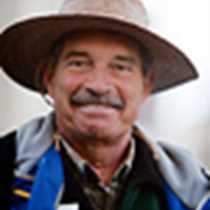In this early, gray morning we visited Thomas Bay. The dreary weather was perfect… This bay is haunted; flying animals with long, coarse hair! Maybe even with wings! For more than a hundred years it was believed there were bad things happening here, all because some prospectors claimed they had almost lost their reason here. But it still is a lovely spot, right next to the land-glacier called Baird. We visited Scenery Cove with delicate fog strips hanging, dark waters lying calm and eerie, marbled murrelets “piping”, and harbor seals slipping silently underwater.
By breakfast time we were anchored at a powerful river flowing down from Cascade Falls - a roaring waterfall so high and powerful that it cannot be scaled by even the strongest of salmon. Some of us walked up to the falls, while others hiked even higher to a husky bridge that spans the roaring water at a narrow canyon. Still others walked higher, into the deeper forest.
Just before lunch we spotted four killer whales. We followed them for a time, noting the damage and deformation of the massive dorsal fin of the big male. These animals were probably “transients”, meaning those killer whales that feed primarily on marine mammals (sea lions, seals, porpoises and whales) and roam the wilds of Alaska and British Columbia without a defined area or territory.
We were ready for Petersburg, a small fishing town founded the century before last by Norwegians, and today a prosperous small city dedicated in full to fisheries - salmon, halibut, black cod, Dungeness crab, shrimp and others. This is a bustling town, with a fantastic series of docks to harbor so many different types of fishing vessels. Purse-seiners, gill-netters, trollers, longliners and crabbers were tucked into their berths. Some of us took helicopter and float-plane rides up into the glaciers nearby, spotting mountain goats and seals, and enjoying the marvels and beauty of rivers of ice flowing down the mountains from icefields and cirques to the ocean. Others hiked up to the nearby muskeg on Kupreanof Island, to learn about the origin of these interesting ecological communities and about the unique plants that make these bogs their home.




